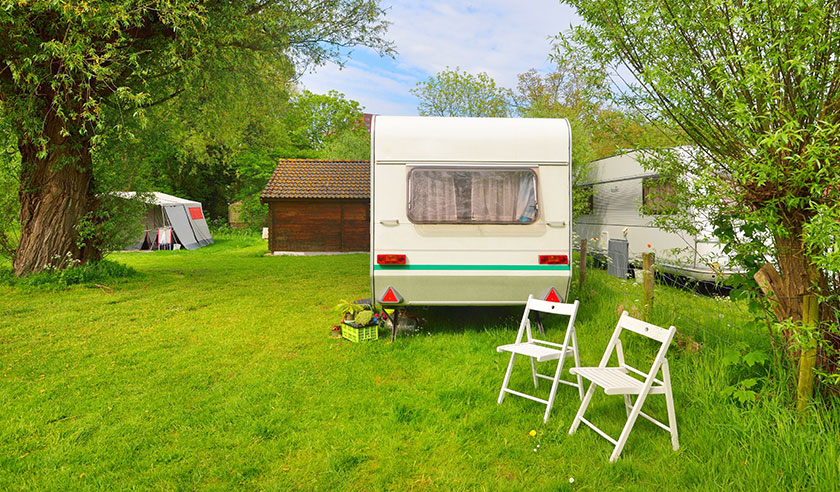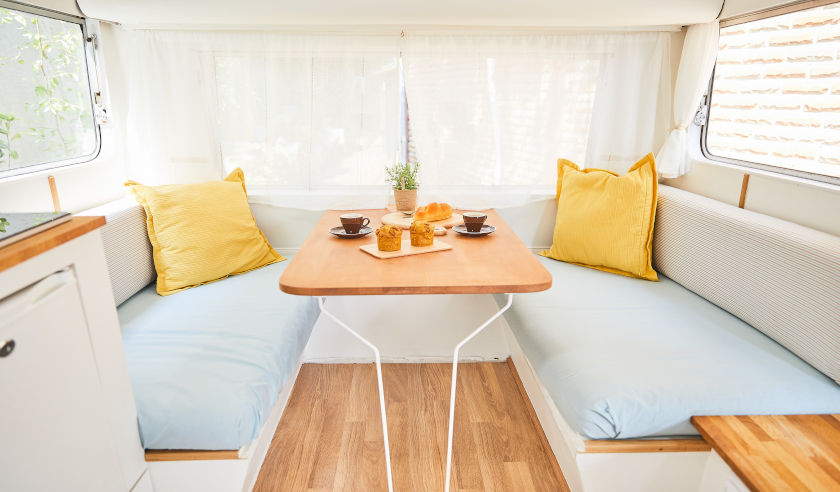In our previous blog, ‘Getting your caravan ready for spring’, we looked at how to check for damage after a long winter in storage, and how to tackle tyre safety, security and servicing. In this blog, we turn our attention to the physical cleaning of your touring caravan, inside and out.
Cleaning the exterior of your caravan
If you take a logical approach to your caravan cleaning, you are less likely to miss any areas; this means starting from the top and working down, to ensure no dirty water cascades over any areas you have cleaned. The roof is an area that people sometimes think they can get away with not cleaning, especially as it can be awkward to clean thoroughly and safely. However, as the largest, flat surface on your caravan, the roof is the place that will attract the most dirt. At the very least, you will need a stepladder to reach but many experts prefer a ladder with protective sponge attached at any points that come into contact with the caravan. Start by gently hosing across the roof to loosen any dirt and algae that may have accumulated. Then, a telescopic wash brush will help you to reach into the middle of the roof, while a pressure sprayer will help you remove dirty water and debris after cleaning (take care to avoid the area around the skylight with the pressure washer). Always use a specialist caravan cleaner such as Silky which has been designed to safeguard the caravan’s surface against abrasions and scratching. For the skylight surround and any stubborn areas along the edges, a soft brush will do the trick. Use with the cleaning solution and rinse well afterwards with a squeegee.
Moving down your caravan, avoid the temptation to use a high-pressure washer. Although it will make short work of the job in hand, a pressure washer maybe too powerful for the sensitive window seals, causing leaks to occur. Play safe and stick to a hose or a sponge with a bucket of water, saving the pressure washer for the wheels.
Your caravan’s windows need special care to avoid scratching them unduly. Start by rinsing away loose dirt, debris and grit before using a specialist cleaner for plastic and acrylic windows, with a microfibre cloth to reduce static. Fenwick’s Windowize will help remove scuff marks and scratches from windows. As with the area around your skylight, the seals around the windows and door can be cleaned with a soft brush. Once dry, all the seals will benefit from an application of silicone grease which can slow down the process of rubber degradation.
Once you have washed the sides of your caravan, you may be disappointed to see black streaks. These are hard to avoid, unless you clean your caravan very regularly, and these are made up of dirt, environmental elements such as moss and also rubber particles – as the rubber seals on your caravan age, small amounts of rubber will come away, washing down the bodywork and sticking to the surface when it rains. A specialist black streak remover will help to keep black streaks at bay in between washes.
Once the outside of your caravan has been thoroughly washed, use a specialist polish such as Fenwick’s Bobby Dazzler to add a protective coating which will help to repel grime, black streaks and algae.
Cleaning the interior of your caravan
Start by opening all windows and doors to help circulate the air, particularly necessary if your caravan has been stored, unused, all winter. Check for any damage to seals and lubricate hinges as you go. Next, vacuum floors, carpets and upholstery thoroughly, using a solution of upholstery shampoo for any stubborn stains that persist. Before you put the vacuum away, don’t forget the storage areas under seats and beds, as well as overhead lockers and cupboards! Removable curtains can be washed and dried or, if they have survived the winter well, simply vacuum them and then hang them in the fresh air to revive them. Where carpets can be lifted and removed, clean them outside before cleaning the flooring where they were laid.
In the kitchen, wash the cupboard fronts well with warm soapy water, and clean the insides with an anti-bacterial spray cleaner and a microfibre cloth. The same anti-bacterial product should be used on all kitchen (and bathroom) surfaces, paying particular attention to the plugs and taps. With the interior windows, the same process should be followed as for the exterior.
After a winter of being unused, the fridge will need special attention. Once any removeable shelves or drawers have been taken out, spray the inside of the fridge either with a solution of vinegar and water or with a solution of bicarbonate of soda and warm water. Leave the solution on any areas of stubborn dirt for ten minutes before wiping clean with a damp cloth. Once all cleaning solution has been removed, dry the inside of the fridge. Wash shelves and drawers well before returning them to the fridge. For a fresh, clean finish, cut a lemon in half and wipe over the interior surface of the fridge. Once you have cleaned the fridge, do not close the door but leave it open slightly so that it remains well ventilated and can dry thoroughly.




















.jpg)

.jpg)
